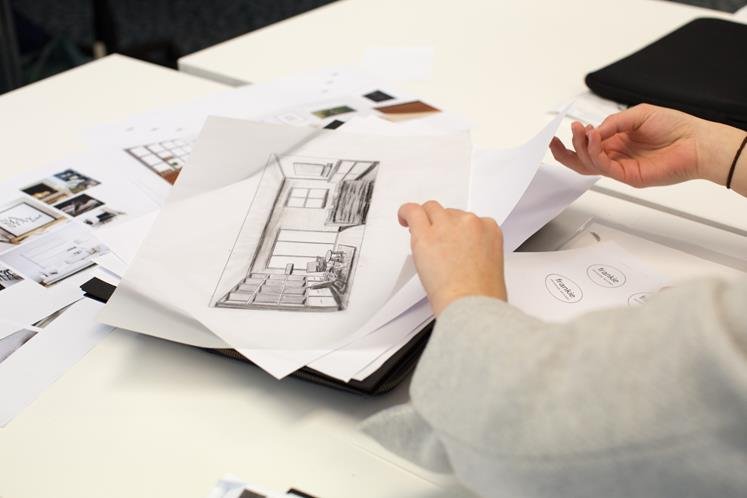Spatial design: insights from Fabrice Höfgen
Workplace design isn’t purely practical – fitting the right number of desks or deciding on a top-of-the-range coffee machine. Neither is it simply about creating a beautiful space. The best design choices bring together aesthetics and functionality, to develop an experience that makes users feel good.
We had a chat with Fabrice Höfgen, a freelance spatial designer with a background in product design and design thinking, to learn more about his practice. Fabrice creates immersive experiences: from exhibitions and trade fairs, to flagship stores and offices. We wanted to hear how spatial design can help shape human-centered workplaces.
Fabrice once used the principles of product and spatial design to create a light installation, in which lights were programmed to replicate a conversation.
What are the principles of spatial design?
Spatial design (if you haven’t heard of it, you’re not alone) is a relatively new specialism. At the heart of spatial design is a focus on people and how they interact with a place – to create adaptable spaces that respond to their changing needs. Spatial designers make use of digital technology to expand our concept of place beyond the boundaries of a physical location.
With this school of thought, each design decision is driven by how people feel in the space. “My practice is really based on human- centeredness,” said Fabrice. “Because of my background as a product designer and design thinker, I keep the people using the space at the center of my process.”
Fabrice sees the relationship between people and place as reciprocal – a conversation that flows in both directions:
“In cities where the sun doesn’t shine, people tend to wear dark colors. But if you go to cities that get a lot of sun, people wear bright colors. So is the sun influencing how we dress? I think on some level, yes, for sure.”
The pillar to the planning of any space in spatial design is human-centeredness.
How can these principles help with designing a workspace?
We wanted to know how Fabrice applied his philosophy of human-centered design to creating better workplaces. He told us that user research is central to the process. “You have to really observe people, to get to know them through interviews and dive deep into their needs, to maybe even discover some that are hidden.”
After understanding what people want from their workplace, the next steps are ideation, prototyping, and testing – “trying out ideas and working with the people you are designing for, to see if it’s a fit.” By testing different concepts, spatial designers can make sure a workplace has the right functionality for each team.
But what about how an office space makes people feel?
“An office should be somewhere you feel at home – a place you would like to go, like a cafe or a nice restaurant. The space should have different types of rooms where you can spend time, so it feels like you have a journey throughout the day.”
As companies shift towards a hybrid working model, Fabrice explained, office design will have to become even more special – to encourage teams to use these spaces.
What does this look like in a hybrid setup?
The workplace is no longer tied to a single geographical location. Post pandemic, 89% of European companies plan on maintaining a hybrid setup. This throws up new questions in the area of workplace design.
One of the greatest challenges with working from home is fostering a sense of connection within teams. Fabrice told us about a recent project that helped a hybrid team with bonding and alignment. The solution was to create a communication channel that allowed quick, direct exchanges – the sort of interactions that are lost when people aren’t working in the same place.
“Beyond that, we tried to recreate the different spaces you find in a physical office. So there was a silent working area, a collaborative zone, and also a social space. With this tool, employees could move themselves between the three categories, so people could see for themselves, ‘Can I talk to this person, or shouldn't I?’ This made a huge impact for teams.”
This concept bridged the gap between office-based employees and those working from home. A virtual map of the new working environment gave employees the opportunity to spontaneously connect with each other, based on availability. This digital aspect of spatial design can help create workplaces that bring remote teams together.
The space at Nuri - a project which both Fabrice and Plantclub worked on.
How can natural elements support a productive working environment?
When we first met Fabrice he was busy designing the office for Nuri – one of our members at Plantclub. Here’s what he had to say about the installation. “I loved all the different plants. It was really nice to see how green the office was.”
Fabrice explained the importance of natural elements in his design process, and how bringing nature into the workplace can create a more productive environment.
“It’s important to feel calm at work, so it helps to incorporate nature into the space. Plants grow and change, and with the importance of topics like climate change and biodiversity, I think using plants is a really impactful way to design. I also like to play with light, to create visual highlights and depth in a room.”
Looking to the future, Fabrice hopes that people will “appreciate the value of spatial design more, and understand what it can do for them.” We look forward to seeing how spatial design reshapes the modern workplace.
Plantclub.io provides you and your colleagues with the benefits of plants, wherever you work. Rent office plants and transform your space into a green oasis, with flexible monthly membership options to suit your size. Diversify your employee perks with a dedicated company store, where you can give green gifts and your team can buy plants for their home office. Book a time to chat with us today.




